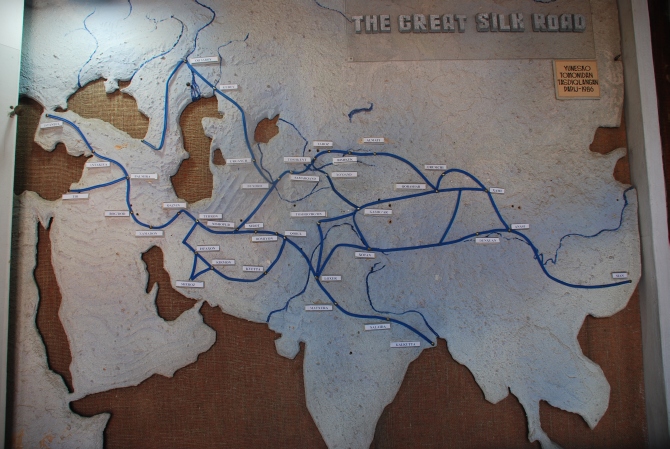 | « Back to article | Print this article |
What Indian drivers do, Kyrgyz drivers seem to do better!
In this second part of a series, Sudha Mahalingam goes deep into silk territory in Kazakhstan and says that the Ferghana Valley seems like a gift from the Gods
Part I: Retracing the Silk Route in breathtaking Kazakhstan
Rubber swallows road as the India Central Asia Foundation-led car rally through Central Asia speeds past some of the most spectacular mountain ranges on planet earth. In 10 days we had crossed the Altai, the Alai, the Tien Shan, the Chat Kol and even just grazed past the Pamirs in Tajikistan, just short by twenty kilometres across the border.
So far we have done 4,000 kilometers and there is at least another 1,000 to go. The road from Bishkek to Osh in KyrgyzRepublic is the most spectacular of all; it runs 700 kilometers almost all of it on mountains and it takes us 14 hours of continuous driving to negotiate this stretch.
Even before we start the climb to Osh, our leader K Santhanam’s car, a Mercedes, no less, springs a leak and the sick green coolant spills and collects in a puddle at the toll gate.
Click NEXT to read further...
What Indian drivers do, Kyrgyz drivers seem to do better!
It is almost two in the afternoon and we worry that we might get stuck on this mountain range which does not host any villages or habitation except for the yurts of tribesmen that sell solidified kumis (mare’s milk) and sundry other produce of this barren landscape. But the driver is undaunted and we resume our drive after some jugaad.
What Indian drivers do, the Kyrgyz drivers seem to do better! To his credit, the car did make it to Osh without incident.
The Tienshan is a tangled skein of mountains and expansive valleys. The road is excellent and slices the mountain range like a ribbon of black silk. Wherever there is some green, there are horses grazing, the silken strands of their golden manes silhouetted against the setting sun. In the valleys, the horizon is almost 360 degrees.
Click NEXT to read further...
What Indian drivers do, Kyrgyz drivers seem to do better!
At Osh, three young medical students -- Raunak, Shamsher and Hemang -- are waiting with hot rice, a wad of freshly made rotis, dal and subzi, all cooked by them in their tiny flat.
Ramakant Dwivedi, the soul of the rally is a man of many parts and very resourceful too. The entire rally is his vision, organization and execution. He arranges for the boys to accompany us through the town and its market.
Our rally makes the crossing from Kyrgyz to Uzbekh border the next day. The customs officials are friendly, spotting some Hindi film star or the other in each one of the youngsters in our party. But nevertheless, they go through the motions of opening our suitcases and checking our unwashed laundry for hidden drugs.
They even open our laptops with our passwords and check our files. Not that they could comprehend anything that was written there, their English being limited to a few words. They go through my camera memory card to check the photos.
Click NEXT to read further
What Indian drivers do, Kyrgyz drivers seem to do better!
Professor P L Dash from BombayUniversity who currently occupies the India Chair and the Indian Cultural Centre and his daughter Leena have come to receive us and they travel with us from the border all through Uzbekistan.
FerghanaValley seems like a gift from the Gods. Every tree has burst into fruits in a celebratory mood after the long winter. You can pluck apples, apricots, quinces, persimmon and walnuts off the boughs and eat them.
Almost every house and shop sports grapevines laden with bunches to which you can help yourself as you walk under them. The people here are chilled out and they like Indians. They are always eager to share their knowledge of Bollywood with visiting Indians.
India has an umbilical link with Ferghana. A young prince from Andijon rebuffed by mightier princes of the province, chose to make his fortune further south, crossed the Khyber Pass and ended up in Delhi. He went on to found a mighty empire and never went back to his native country although he often missed the sweet melons and other fruits of his native Ferghana.
Click NEXT to read further
What Indian drivers do, Kyrgyz drivers seem to do better!
In Andijon, we visit the modest house in which Babur was born. Of course, it has been rebuilt and converted into a museum. Just outside is the flea market where iron implements and hardware stalls line the street. Andijon seems an unlikely town to have given birth to the Great Moghul.
Kokand, spelt Qoqand by the locals, however, is not. It used to be the capital of the Kokand Khanate until 1876 when the Russian tanks rolled into Ferghana. Khodyarkhan’s impressive citadel still stands with a few courtyards and some remnants of his household showcased in the museum. The local crowds that have come to see the museum are more interested in this Indian delegation than their own history.
We meet Dinesh Prabu, a textile engineer who has come all the way from Tirumangalam in Tamil Nadu to set up the textile machinery for Indo Rama textiles, an Indian company. Ferghana is cotton paradise and cotton fields bursting with flowers line both sides of the road.
At Margillon, we visit a silk factory where the prices, quoted in dollars and can make Saks Fifth Avenue look like bargain basement. Similarly, the ceramic factory in Rishton quotes astronomical prices, fixed entirely for tourist crowds. We come away empty-handed, hoping to buy the same stuff for a fraction of the price in Tashkent.
TOP photo features you missed last week
Click on MORE to see another PHOTO features...





